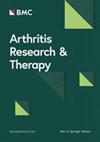Exploring the therapeutic effect of human recombinant IL11 on lesioned OA human osteochondral explants
IF 4.9
2区 医学
Q1 Medicine
引用次数: 0
Abstract
To explore IL11 co-expression profiles in our previously reported RNA-sequencing dataset of OA articular cartilage, in interaction with IL6, and to investigate the effects of hrIL11 administration as potential therapeutic strategy for OA articular cartilage using our biomimetic aged human osteochondral explant model of OA. We used RNA-sequencing datasets of macroscopically preserved and lesioned OA articular cartilage (N = 35 patients). Spearman correlations were calculated between IL11 and IL6 expression levels and genes expressed in cartilage (N = 20048 genes). Osteochondral explants were isolated from macroscopically preserved and lesioned areas of the joint and were kept in culture for two weeks, with or without exposure to 200ng/ml hrIL11. We found no overlap in correlating genes between IL11 and IL6, indicating their distinct roles in articular cartilage. Moreover, we identified more genes being correlated to IL11 in the lesioned compared to preserved articular cartilage (N = 203 and 106 genes, respectively). Upon treatment of ex vivo OA articular cartilage with hrIL11, we overall observed unbeneficial effects on chondrocyte phenotype, as illustrated by upregulation of MMP13, EPAS1, RUNX2, and POSTN. We did not observe significant differences in Mankin scores upon addition of hrIL11. The current study showed that treatment of OA articular cartilage with hrIL11 is unlikely to be beneficial despite previous indications of hrIL11 as potential druggable target. These findings underscore the importance of functionally investigating OA risk genes. Better understanding of IL11 signaling and the underlying pathways is necessary towards the development of OA treatment strategy.求助全文
约1分钟内获得全文
求助全文
来源期刊

Arthritis Research & Therapy
RHEUMATOLOGY-
CiteScore
8.60
自引率
2.00%
发文量
261
审稿时长
14 weeks
期刊介绍:
Established in 1999, Arthritis Research and Therapy is an international, open access, peer-reviewed journal, publishing original articles in the area of musculoskeletal research and therapy as well as, reviews, commentaries and reports. A major focus of the journal is on the immunologic processes leading to inflammation, damage and repair as they relate to autoimmune rheumatic and musculoskeletal conditions, and which inform the translation of this knowledge into advances in clinical care. Original basic, translational and clinical research is considered for publication along with results of early and late phase therapeutic trials, especially as they pertain to the underpinning science that informs clinical observations in interventional studies.
 求助内容:
求助内容: 应助结果提醒方式:
应助结果提醒方式:


